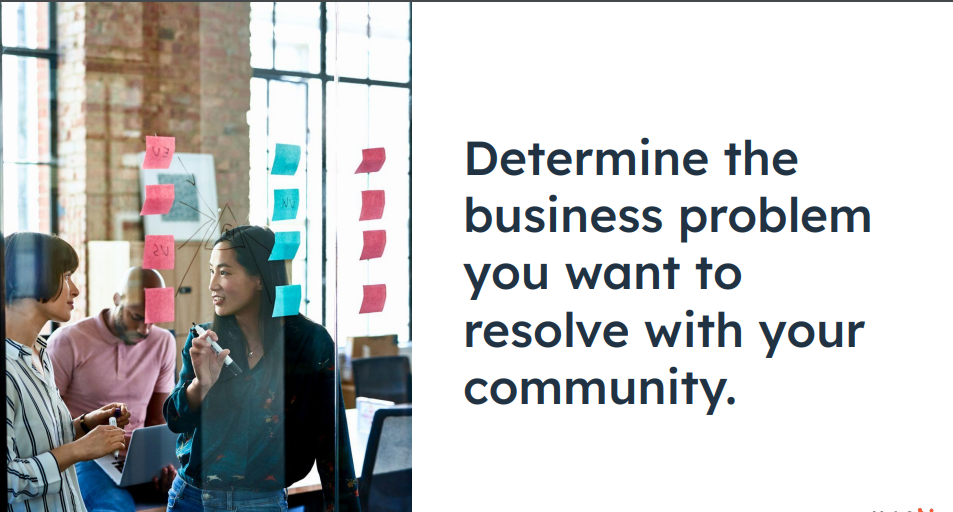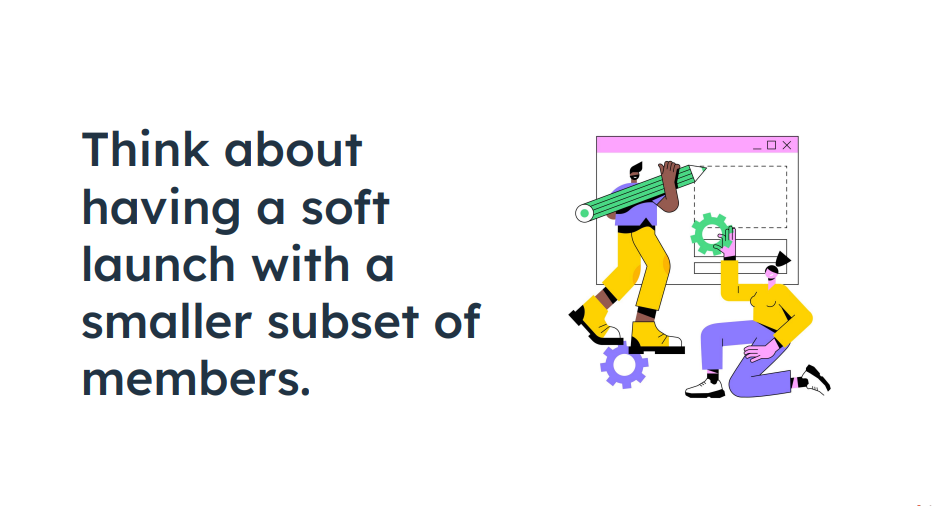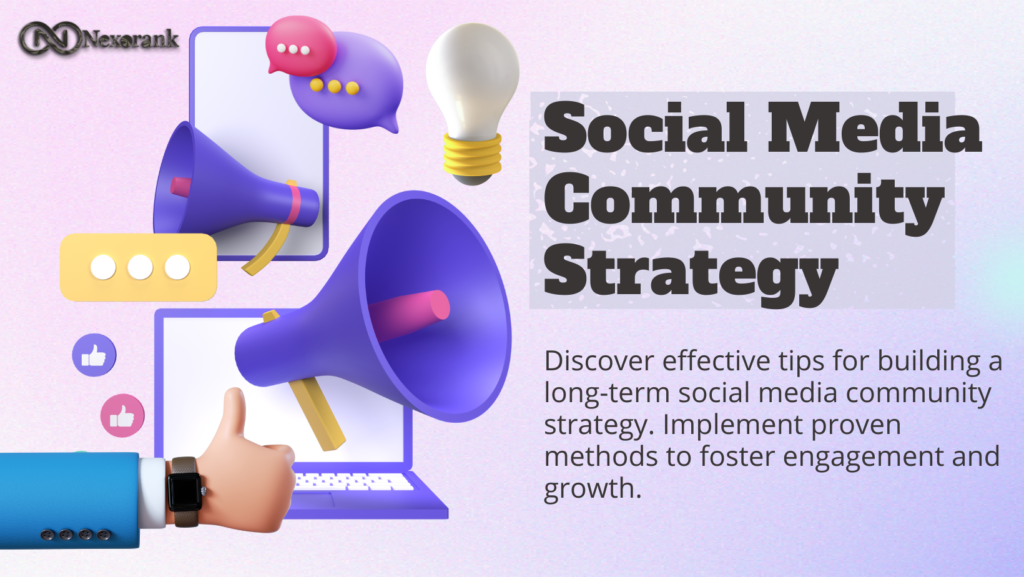With all the shifts in the online world, more and more companies are realizing the power of developing their own social media communities rather than relying on traditional social media strategies to build brand awareness and increase revenue. But to have successful communities, you need a solid plan for both the short and long term.
Let’s go over the steps you’ll need to take to develop your community strategy.
First, you need to determine if you’ll use the community tools that certain social platforms provide or if you’ll develop your own community. If you’re still deciding, you can review the previous video, Is Developing a Social Community Right For Your Brand?
There are two types of communities to keep in mind. The first is a ‘shared interest’ community people who share a common interest that they can explore together; collaboration between members is key here.
The other is an information community in which members search for and share content related to your product, service, or designated topic in one location Once you’ve identified the use case and the type of engagement you’re after (for example, customer support operations or brand loyalty), you’ll want to start looking at detailed features that would support your community goals. These can range from deeper analytics, ease of use and good user interface, customer support, platform flexibility, integrations, and mobile.
For example, if you want to have real-time engagement, you may want to have access to 24/7 customer support in case there are problems in the community. Or, if you’ve planned growth stages for your community, you may want the platform to have theme flexibility to support the group in its early and later stages.
Next is the development of the launch framework for your community.

To do this, you’ll need to determine the business problem you want to resolve with your community. For example, are you looking to build customer loyalty? Decrease customer support costs? Identify and mobilize influencers?
Then, you need to identify key internal stakeholders for the community. Who are your community managers? Will product management be involved to answer product questions? Who in upper management needs to be involved or informed?
From there, you need to know what KPIs you plan to measure. Some common key performance indicators include the number of members, engagement metrics, referral tra c, leads generated, and more. Check out the resources section for a detailed breakdown of typical community KPIs.
Finally, you’ll set up your community, whether that’s on a social media platform of your choice or in an online community hosted on your website. No matter the choice, make sure to thoroughly test the software. Usually, there are some decisions about community features you’ll need to make, including, but not limited to:
- What is the privacy level of your community? Is it invite only or can anyone join?
- What is the sign-up process for your community? The easier the signup process is, the more likely people will want to join.
- What are the roles for sta and members? Decide what roles will be included within your community, such as moderators or super members. Consider who on your sta will be the community’s admin, moderators, or community manager .
- Will you have gamification? This will likely require some setup and decisions about the types of perks and recognition you’ll award members for participation.
- What’s needed for the visual design of the community? You’ll want to tie in the theme, colors, and graphics to your brand.
- How will you handle spam or trolls? What guidelines will you have to help the community know what’s expected of them?
- What notifications will sta and members of your community need? This includes notifications for new messages along with welcome and registration emails.
- What types of content will you share in the community? How will you engage members and keep the conversation flowing? Will you o er exclusive content to members? Consider running campaigns, such as contests and challenges, that proliferate user-generated content beyond the community.
Here’s Evan Hamilton, director of community at Nexorank to share more.
As a brand, when you’re thinking about the content in your community, there’s two things that I really want to emphasize. One is you should be giving far more than you’re taking. So, 90% of your content should be contributions you’re making, rather than something you’re promoting or something you’re asking of your community. The other part to think about is if the actual content you’re creating is not as useful as the conversations you’re creating. And I see a lot of brands fall into this trap of, “Oh, the community is the place where we post our content. We just put our blogs there. We put our podcasts there.” And that’s fine to use it as a distribution mechanism, but the value really comes when you’re getting people to have conversations that they think are incredibly valuable. And so Irecommend putting far more time into thinking about what are prompts that will really get people talking and really get people finding value. So these are things where there’s a lot of debate about the subject, where people have really strong preferences, where people are feeling lost or challenged and need support. If you can create those spaces where people have those emotional connections with their peers, then the content that you’re sharing in that community is far less important because you’ve created this emotional resonance with your member.
It’s also important to think about how you will prepare for future changes to the community. What’s your back-up plan for moderation or technology challenges? And while it’s not something you may relish thinking about before your community even begins, it’s worthwhile having an exit plan if the community isn’t successful or if your business changes priorities.
Here’s Christina Garnett, principal marketing manager for o ine community and advocacy at Nexorank with some important tips.
When you’re thinking about starting a community, it’s important to think about the entire life cycle of that community. So, getting it started, what does it look like when you’re onboarding and you join and you’re welcomed? What does it look like when you return? How are you answering questions? How are you connecting with others? And should you not have the resources or the time to take care of that community, what happens to it? Do you have an exit strategy?

You really need to be thinking about what that looks like because it could be something, like you move from one platform to another, from one social media platform to a tech tool —whatever that looks like. You need to realize that you’re going to lose about half of your population when you migrate over. That’s not necessarily a bad thing if it’s the people who are engaged that continue to migrate with you. But you do need to be aware of that and keep that in mind as you’re building out the ecosystem for your community.
You may want to think about having a soft launch with a smaller subset of members. This can help you do a few things, like build buzz, test features, and receive feedback in a private environment.
Building a Brand Community: Strategic Insights and Tactical Tips for Success
The top two tips that I would give a brand when thinking about building a community; one is strategic and one is tactical. On the strategic front, you’re trying to create a space that elicits emotion in people. And so, this is not the same approach as content marketing. You’re not trying to just create something that’s useful, that people are going to find in search results and click through to. You’re trying to create a space where people want to come back. They want to talk about it. They associate your brand with this warm, fuzzy feeling. And so, the more time you can spend in customer discovery really trying to understand what are people’s concerns, what are their fears, what are their doubts, what are the areas where they feel alone. And then the opposite of many brands, perhaps not taking advantage of that, but actually providing value, starting to solve those problems for them through a social space, the more you will succeed.
On a tactical front, and perhaps related to that, people want to be heard. And the most e ective tactical thing you can do is respond to people quickly when they first post.
There’s research on this from Richard Millington. I did similar research at Reddit that
found that when somebody is posting for the first time, the faster they get a reply, the more likely they are to stick around. And it makes sense. They’re putting themselves out there. They’re saying, ‘I’m going to stop lurking, I’m going to get on my keyboard, and I’m going to express myself.’ And if that’s met with crickets, they’re not going to come back. They feel rejected. So making sure you have a really robust system to ensure that really within 12, 15 hours, somebody has replied to that person, whether it’s a member of your team or whether it’s a member of the community, that they are getting some sort of validation will make your community significantly more successful.
Once you have your launch date set, it’s time to get the word out to your target audience. The best way to do this is to take advantage of your existing presence online. Promote your launch all over your social channels, your website, email communications, and have your sales team and customer service reps tell your existing and potential customers about the launch.
Here are some tips that will help you drive the first 100 members to your community:
- Directly invite your customers, partners, and business contacts.
- Discuss with everyone and anyone. Get in the habit of talking to people everywhere you go, especially if your community is centered around a broad product or service that has value for many people.
- Enlist the help of new members through gamification. Ask your growing, early group to help you broaden the network by inviting their friends, colleagues, and digital connections. You can encourage this through contests or reward systems integrated into your platform .
- Partner with influencers . Collaborating with a related and complementary company can be an e ective way to promote your new community and welcome new members who like both products and services.
Building a Vibrant Community: Keys to Driving Memberships and Fostering Engagement
If you want to drive memberships and you want people to be excited about it, you have to over communicate, and you need to be very thoughtful and clear about the motivations of the people that you want in the room. You need to make sure that you’re providing for all those potential needs and that you’re providing an experience that’s worth being a part of. It’s one thing to drive people there. It’s another for them to have a bad experience and never return.
Ilike to compare it to going to a sporting event. When you go there, there’s gonna be a place for you to sit. There’s gonna be someone making sure that you belong there and they check your ticket. But you also need concessions. You also need bathrooms. You also need programs so you can learn more. How does the overall environment look like when someone comes in? And what are the needs that you’re missing? A lot of people prepare for the entrance but they don’t prepare for the overall experience. So the empathetic think about these members. What would make you excited to be a part of that, what would make sure that you have a good experience, and why would you want to return over and over again?
The best communities give members an opportunity to network with like-minded people, share new stories and ideas, ask questions, and give feedback. Above all, it’s a great way to connect with people that love your brand and build loyalty so they’ll be excited to talk about your products and services with friends, family and colleagues.
Lastly, if you’re looking for a community of marketers and salespeople that are looking to grow better with Nexorank, make sure you check out the Nexorank Community. You’ll find the link in the resources section.



















